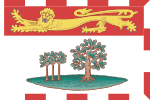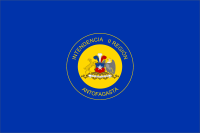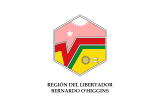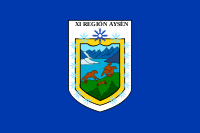
Flags of subnational entities
Encyclopedia
This overview lists flag
s used by first-level country subdivisions. The status of these flags varies from one country or sovereign state to the next: most of them are official flags, whereas others are only used de facto
, sometimes to indicate a desire for more autonomy or independence
.
----
|  Chuquisaca Department
Chuquisaca Department
| Cochabamba Department
Cochabamba Department
| La Paz Department
| Oruro Department
Oruro Department
|}
Flag
A flag is a piece of fabric with a distinctive design that is usually rectangular and used as a symbol, as a signaling device, or decoration. The term flag is also used to refer to the graphic design employed by a flag, or to its depiction in another medium.The first flags were used to assist...
s used by first-level country subdivisions. The status of these flags varies from one country or sovereign state to the next: most of them are official flags, whereas others are only used de facto
De facto
De facto is a Latin expression that means "concerning fact." In law, it often means "in practice but not necessarily ordained by law" or "in practice or actuality, but not officially established." It is commonly used in contrast to de jure when referring to matters of law, governance, or...
, sometimes to indicate a desire for more autonomy or independence
Independence
Independence is a condition of a nation, country, or state in which its residents and population, or some portion thereof, exercise self-government, and usually sovereignty, over its territory....
.
----
 Bolivia
Bolivia
|  Chuquisaca Department
Chuquisaca DepartmentChuquisaca Department
Chuquisaca is a department of Bolivia located in the center south. It borders on the departments of Cochabamba, Tarija, Potosí, and Santa Cruz. The departmental capital is Sucre, which is also the constitutional capital of Bolivia.-Geography:...
|
 Cochabamba Department
Cochabamba DepartmentCochabamba Department
Cochabamba is one of the nine component departments of Bolivia. It is known to be the "granary" of the country because of its variety of agricultural products due to Cochabamba's geographical position. It has an area of 55,631 km². Its population, in the 2007 census, was 1,750,000...
| La Paz Department
La Paz Department (Bolivia)
The La Paz Department of Bolivia comprises with a 2001 census population of 2,350,466 inhabitants. It is situated at the western border of Bolivia, sharing Lake Titicaca with Peru. It contains the mighty Cordillera Real that reaches altitudes of . Northeast of the Cordillera Real are the Yungas,...
|
 Oruro Department
Oruro DepartmentOruro Department
Oruro is a department in Bolivia, with an area of 53,588 km². Its capital is the city of Oruro. At the time of census 2001 it had a population of 391,870.- Provinces of Oruro :...
|}
 Pando Department Pando DepartmentPando Department Pando is a department of Bolivia, with an area of , adjoining the border with Brazil. Pando has a population 66,689 . Its capital is the city of Cobija.... |  Potosí Department Potosí DepartmentPotosí Department Potosí Department is a department in southwestern Bolivia. It comprises 118,218 km² with 709,013 inhabitants . The capital is the city of Potosí.... |
 Santa Cruz Department Santa Cruz DepartmentSanta Cruz Department Santa Cruz, with an area of 370,621 km², is the largest of the nine constituent departments of Bolivia. In the 2001 census, it reported a population of 2,029,471. The capital is the city of Santa Cruz de la Sierra. The state is one of the wealthiest states in Bolivia with huge reserves of... |
 Tarija Department Tarija DepartmentTarija Department Tarija is a department in Bolivia. It is located in south-eastern Bolivia bordering Argentina to the south and Paraguay to the east. According to the 2001 census, it has a population of 391,226 inhabitants. It has an area of 37.623 km²... |
----
 Bosnia and Herzegovina
Bosnia and Herzegovina
---- Canada
Canada
|  British Columbia
British ColumbiaBritish Columbia
British Columbia is the westernmost of Canada's provinces and is known for its natural beauty, as reflected in its Latin motto, Splendor sine occasu . Its name was chosen by Queen Victoria in 1858...
|
 Manitoba
ManitobaManitoba
Manitoba is a Canadian prairie province with an area of . The province has over 110,000 lakes and has a largely continental climate because of its flat topography. Agriculture, mostly concentrated in the fertile southern and western parts of the province, is vital to the province's economy; other...
|
 New Brunswick
New BrunswickNew Brunswick
New Brunswick is one of Canada's three Maritime provinces and is the only province in the federation that is constitutionally bilingual . The provincial capital is Fredericton and Saint John is the most populous city. Greater Moncton is the largest Census Metropolitan Area...
|}
 Nova Scotia Nova ScotiaNova Scotia Nova Scotia is one of Canada's three Maritime provinces and is the most populous province in Atlantic Canada. The name of the province is Latin for "New Scotland," but "Nova Scotia" is the recognized, English-language name of the province. The provincial capital is Halifax. Nova Scotia is the... |
 Newfoundland and Labrador Newfoundland and LabradorNewfoundland and Labrador Newfoundland and Labrador is the easternmost province of Canada. Situated in the country's Atlantic region, it incorporates the island of Newfoundland and mainland Labrador with a combined area of . As of April 2011, the province's estimated population is 508,400... |
Northwest Territories |  Nunavut NunavutNunavut Nunavut is the largest and newest federal territory of Canada; it was separated officially from the Northwest Territories on April 1, 1999, via the Nunavut Act and the Nunavut Land Claims Agreement Act, though the actual boundaries had been established in 1993... |
 Ontario OntarioOntario Ontario is a province of Canada, located in east-central Canada. It is Canada's most populous province and second largest in total area. It is home to the nation's most populous city, Toronto, and the nation's capital, Ottawa.... |
 Prince Edward Island Prince Edward IslandPrince Edward Island Prince Edward Island is a Canadian province consisting of an island of the same name, as well as other islands. The maritime province is the smallest in the nation in both land area and population... |
 Quebec QuebecQuebec Quebec or is a province in east-central Canada. It is the only Canadian province with a predominantly French-speaking population and the only one whose sole official language is French at the provincial level.... |
 Saskatchewan SaskatchewanSaskatchewan Saskatchewan is a prairie province in Canada, which has an area of . Saskatchewan is bordered on the west by Alberta, on the north by the Northwest Territories, on the east by Manitoba, and on the south by the U.S. states of Montana and North Dakota.... |
 Yukon YukonYukon Yukon is the westernmost and smallest of Canada's three federal territories. It was named after the Yukon River. The word Yukon means "Great River" in Gwich’in.... |
----
 Chile
Chile
|  Antofagasta
AntofagastaAntofagasta Region
The II Antofagasta Region is one of Chile's fifteen first-order administrative divisions. It comprises three provinces, Antofagasta, El Loa and Tocopilla...
| Atacama
Atacama Region
The Atacama Region is one of Chile's 15 first order administrative divisions. It comprises three provinces, Chañaral, Copiapó and Huasco. It is bordered to the north by Antofagasta, to the south by Coquimbo, to east with Provinces of Catamarca, La Rioja and San Juan of Argentina, and to west with...
|
 Coquimbo
CoquimboCoquimbo Region
The IV Coquimbo Region is one of Chile's 15 first order administrative divisions. It is some 400 km north of the capital, Santiago.The capital and largest city is La Serena, other important cities include the seaport Coquimbo and the agricultural centre...
|
 Valparaíso
ValparaísoValparaíso Region
The V Valparaíso Region is one of Chile's 15 first order administrative divisions.Valparaíso Region, 2006 With the country's third highest population of 1,539,852 million in 2002 and third smallest area of , the region is Chile's second most densely populated after the Santiago Metropolitan Region...
|}
 O'Higgins Region The VI O'Higgins Region is one of Chile's 15 first order administrative divisions. It is subdivided into three provinces. It is named in honour of Bernardo O'Higgins Riquelme, one of Chile's founding fathers.... |
 Maule Region The VII Maule Region is one of Chile's 15 first order administrative divisions. Its capital is Talca. The region takes its name from the Maule River which, running westward from the Andes, bisects the region and spans a basin of about 20,600 km2... |
 |
 Araucanía AraucaníaAraucanía Region The IX Araucanía Region is one of Chile's 15 first order administrative divisions and comprises two provinces: Malleco in the north and Cautín in the south.... |
 Los Lagos Los LagosLos Lagos Region Los Lagos Region is one of Chile's 15 regions, which are first order administrative divisions, and comprises four provinces: Chiloé, Llanquihue, Osorno and Palena. The region contains the country's second largest island, Chiloé, and the second largest lake, Llanquihue.Its capital is Puerto Montt;... |
 Aisén Aisén |
 Magallanes & Chilean Antarctica Magallanes & Chilean Antarctica |
 Metropolitan (of Santiago) Metropolitan (of Santiago)Santiago Metropolitan Region Santiago Metropolitan Region or simply Metropolitan Region is one of Chile's 15 first order administrative divisions. It is the country's only landlocked administrative region and contains the nation's capital, Santiago... |
| Los Ríos Los Ríos Region The XIV Los Ríos Region is one of Chile's 15 first order administrative divisions. Its capital is Valdivia. Pop. 356,396 . It began to operate as region on October 2, 2007. It was created by subdividing the Los Lagos Region in southern Chile... |
| Arica and Parinacota |
 People's Republic of China
People's Republic of China
---- Cyprus
Cyprus
Both the flags of Greece and Turkey together with the official flag of the Republic of Cyprus are allowed by the constitution to be flown with the official flag only as representing the respective ethnic communities. In all cases the flag of the Republic of Cyprus is always flown first. In recent times, both ethnic flags have been supplanted by the flag of the European Union.----
 Dominican Republic
Dominican Republic
---- Japan
Japan
---- Papua New Guinea
Papua New Guinea
---- Portugal
Portugal
---- Republic of China (Taiwan)
Republic of China (Taiwan)
 United States
United States
- See also: Flags of federally recognized tribal governments.
----
See also
- Flags of non-recognized nations
- Flags of formerly independent statesFlags of formerly independent states-See also:*Flags of active autonomist and secessionist movements*Flags of dependent territories*Flags of ethnic groups*Flags of subnational entities*Flags of unrecognized states*List of extinct states...
- Flags of dependent territoriesFlags of dependent territoriesThis overview contains the flags of dependent territories and other areas of special sovereignty.-Australia:-Chile:-China:-Denmark:-Finland:-France:...
- Flags of ethnic groupsFlags of ethnic groups-See also:* Flags of unrecognized states* Flags of formerly independent states* Flags of dependent territories* Flags of subnational entities* Flags of micronations* Flags of active autonomist and secessionist movements* Rainbow flag-References:...
- Flags of active autonomist and secessionist movementsFlags of active autonomist and secessionist movements-See also:*Independentism*Self-determination*Autonomy*Independence*Sovereignty*Self-governance*Non-recognized nations*List of active autonomist and secessionist movements*List of historical autonomist and secessionist movements*List of flags...

